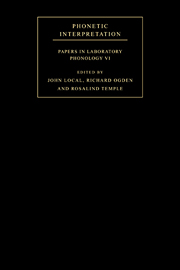Book contents
- Frontmatter
- Contents
- List of contributors
- Acknowledgements
- Introduction
- Part I Phonological representations and the lexicon
- Part II Phonetic interpretation and phrasal structure
- 6 Release the captive coda: the foot as a domain of phonetic interpretation
- 7 How many levels of phrasing? Evidence from two varieties of Italian
- 8 Domain-initial articulatory strengthening in four languages
- 9 External sandhi as gestural overlap? Counter-evidence from Sardinian
- 10 Commentary: Consonant strengthening and lengthening in various languages
- Part III Phonetic interpretation and syllable structure
- Part IV Phonology and natural speech production: tasks, contrasts and explanations
- References
- Index of names
- Index of subjects
9 - External sandhi as gestural overlap? Counter-evidence from Sardinian
Published online by Cambridge University Press: 22 September 2009
- Frontmatter
- Contents
- List of contributors
- Acknowledgements
- Introduction
- Part I Phonological representations and the lexicon
- Part II Phonetic interpretation and phrasal structure
- 6 Release the captive coda: the foot as a domain of phonetic interpretation
- 7 How many levels of phrasing? Evidence from two varieties of Italian
- 8 Domain-initial articulatory strengthening in four languages
- 9 External sandhi as gestural overlap? Counter-evidence from Sardinian
- 10 Commentary: Consonant strengthening and lengthening in various languages
- Part III Phonetic interpretation and syllable structure
- Part IV Phonology and natural speech production: tasks, contrasts and explanations
- References
- Index of names
- Index of subjects
Summary
Models of assimilatory external sandhi
External sandhi stands right at the heart of a number of current issues in phonology and phonetics. The traditional assumption is that such ‘phonological adjustments’ involve the categorical modification of the affected segment or segments, e.g. the coalescence in English of /t#j/ to /t ∫/ in past your prime, or the change in that case of /t#k/ to /k/. Hayes's (1986a) analysis of the assimilatory external sandhi of Toba Batak established that autosegmental feature spreading, the canonical mechanism for analysing assimilation (Goldsmith 1979; Clements 1976), was able to account for complex sandhi patterns just by linking and delinking autosegments. Such feature spreading, which relies crucially on the traditional assumption of categorical phonological modifications at word boundaries, has subsequently been the received analysis of external sandhi generally, including the English cases mentioned above.
More recently, however, a number of studies on English (Barry 1985; Wright and Kerswill 1989; Browman and Goldstein 1989, 1990b; Nolan 1992; Holst and Nolan 1995; Nolan, Holst and Kühnert 1996; Zsiga 1995) have cast doubt on the assumption that external sandhi assimilation involves categorical modifications of segments. Rather, the appropriate processes appear to involve language-specific rules of phonetic co-articulation, usually expressed in terms of gestural overlap and gestural reduction.
- Type
- Chapter
- Information
- Phonetic InterpretationPapers in Laboratory Phonology VI, pp. 164 - 182Publisher: Cambridge University PressPrint publication year: 2004



